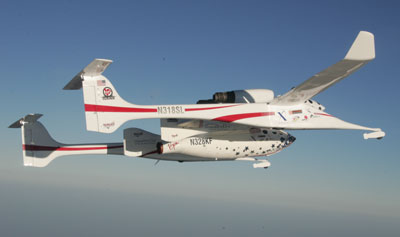A Guggenheim Fund for spaceflightby Pat Bahn
|
| What we lack, though, is a technical research foundation: a Guggenheim Space Foundation, as it were. |
We have industrial associations such as the Personal Spaceflight Federation, National Coalition of Spaceport States (the author is eternally grateful they did not select the more direct but incredibly unfortunate name of the Association of Spaceport States), and the Suborbital Institute, amongst others. The X Prize Foundation is running achievement prizes and the Heinlein Foundation is awarding broad area achievement.
What we lack, though, is a technical research foundation: a Guggenheim Space Foundation, as it were. For those unfamiliar with the history, a brief discussion may be worthwhile. The Guggenheims were wealthy industrialists of the 19th Century and one child of the family became interested in the emerging field of aeronautics. His father decided, as part of a role of giving back to society, to endow a foundation to promote aeronautics. The Centennial of Flight Commission has a marvelous paper on this topic, which this author does little justice to. Nevertheless, the Daniel Guggenheim Fund chose as a mission to:
- Improve aeronautical education
- Improve aeronautical research
- Develop aircraft and equipment
- Promote Applications of aircraft
The state of flight in the 1920’s was very poor. Accidents were common, the craft were very crude, and the flood of surplus aircraft from the Great War had depressed sales. The Guggenheims started off by endowing a handful of college research laboratories to train young engineers and to create pools of like-minded professors. These schools included Caltech, Stanford, Michigan, Ohio, MIT, Wisconsin, and Georgia Tech.
The Guggenheim Fund paid to develop new instruments helping to prove the gyrocompass, the artificial horizon, precision altimeters, and radio navigation aids. The Fund also sponsored prize contests for safe aircraft designs. Their prize contests led to the development of the flap, the slat, and improved landing gear. The Fund also operated a model airway between San Francisco and LA and demonstrated weather reporting networks for aviation, the descendants of which are still in use today. (After less than ten years the Guggenheim Fund closed, having declared that it had met its principal objectives, although other Guggenheim family funds continued some participation in aviation endeavors.)
This fund was of critical importance in building the American aviation industry and serving as a coordinating body for industry, government, academia, and inventors. Thus, it appears ripe to create a similar foundation for the suborbital spaceflight industry. The creation of a fund sponsored by an individual of significant wealth would have real impact to a nascent industry. Currently, government efforts to explore suborbital systems are either focused on narrow mission areas or underfunded. The associations are, at best, loose confederations of interest without the resources to drive projects to success. Industry is far too focused on milestones to be able to fund broad ranging goals and the current foundations lack charter or resources to do this. If a Paul Allen, Warren Buffett, or other similar individual were to create a “Guggenhiem fund” for the promotion of spaceflight, we would see real progress in a short period of time.
A new Guggenheim fund could, though the sponsorship of faculty positions to research needs of the industry, support safety methods in the handling of fuels with an eye towards routine flight operations, aid the design of stable vehicles, and support demonstrations of economic activities from spaceships such as fast package delivery, remote sensing, or materials processing. Let us consider what this would take:
| For the investment of a billion dollars, a foundation could create significant progress in space and move industry, government, and academia forward into a new space age. |
To sponsor ten schools as before with, say, two professors with labs could be done for ten years for $200 million. This would fund equipped laboratories, six to eight graduate students, numerous undergrads, and provide funding for research topics and demonstrations. Funding technical systems demonstrations could be done at the single digit million level. For example, two technical demos per year could be funded for $20 million. Now for each successful demo, we figure nine others fail, so to be safe, we should budget $200 million here also.
A safe vehicle design contest could be funded at, say, the $200 million level, giving $100million to the winner—who is required to publish their design to industry—and smaller prizes to the runners-up, who have to license their innovations to all comers for a nominal sum.
A model tourist operation could be sponsored for a year or two for no more then $200 million with rides given to journalists, public officials, teachers, authors, and leading citizens, providing key decision makers with a real taste of space experiences.
Perhaps another $200 million could be spent on projects that work to involve the general public in symbolic ways. The Guggenheim Fund sponsored the painting of town names on building roofs to help flyers navigate; perhaps a sponsorship of planting crops in such a way they are visible from a spaceship, or the placement of bright reflectors that could be seen from over 60 kilometers away.
For the investment of a billion dollars, a foundation could create significant progress in space and move industry, government, and academia forward into a new space age. That this amount exceeds the resources of current funds is obvious, but, perhaps funds like the Sophron Foundation, the Heinlein Foundation, or the X Prize Foundation could sponsor a framework agreement and bring the appropriate individuals to meetings to discuss this kind of endeavor. It is unfortunate that FINDS, the Foundation for Independent Non-governmental Development of Space, never had this charter and has become defunct at this time. FINDS certainly was the largest of the space-related development foundations.
The required investment is significant, but the social rewards will be enormous.
